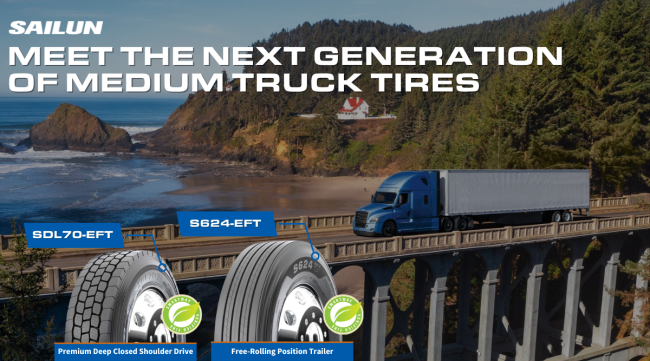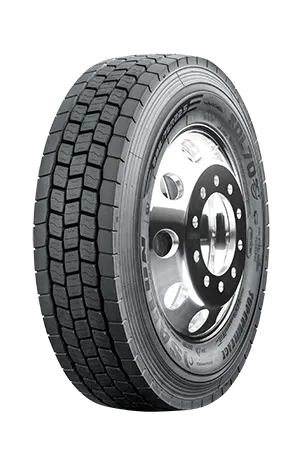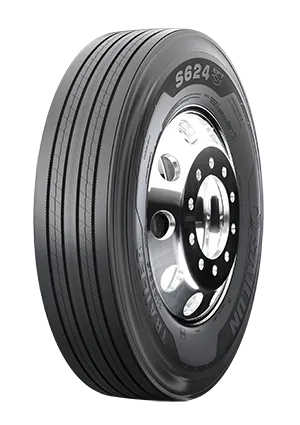Cost-Cutting Measures

With the North American trucking industry facing significant headwinds, and as fleet operators look for ways to cut costs, Sailun Tire Americas is working on solutions that will allow fleets to save on tires, and on fuel.
Advances in tire technologies have allowed Sailun to introduce two new tires to the North American market that combine fuel economy with a longer tread life and excellent grip—all at a value price that’s hard to beat.

SDL70 EFT
When you consider the challenges currently facing the trucking industry, Sailun’s new tires couldn’t have come to market at a better time. “Right now, the trucking industry is up against the wall,” explains Justin Large, Director of Sales, North America at Sailun Tire Americas. “They're calling it ‘the great trucking recession.’ The rates have never been lower, but their operating costs are higher than they've ever been due to driver wages, technician wages, insurance, fuel, you name it.”
Naturally, fleets need a way to cut their operating costs, but that’s easier said than done. “The logical first step to lowering operating expenses is to look for ways to cut the cost of either fuel, insurance or tires,” Large adds. “You can’t really negotiate the cost of fuel or insurance, so the next logical step is to look at your tire program.”
This is where Sailun’s new tires can make all the difference. “We’re offering tier-one performance at a value price,” Large explains. “So as far as total cost of ownership is concerned, no one can match what we’re able to offer.”
Fuel-Saving Tires

S624 EFT
Sailun is introducing two new tires, both of which have been designed to cut fuel costs. Engineered to optimize long-haul operations, the Sailun S624 EFT is a premium free-rolling position trailer tire for on-highway applications, while the Sailun SDL70 EFT is a premium closed shoulder drive tire. “Both of these tires are premium models, within our value lineup,” explains Al Eagleson, Segment Manager, Commercial Tires at Sailun Tire Americas.
Both tires take advantage of innovations in tire design, and in the manufacturing process, which in turn allows Sailun to offer products that tick all the boxes for fleets. More importantly, Sailun can do so at a price that’s significantly lower than what some tier-one brands can offer.
Benefits of Liquid-Phase Mixing
One of the key innovations that places these new Sailun tires head-and-shoulders above the competition is liquid-phase mixing. “This is a huge benefit for long-haul tires,” Eagleson explains, “because it allows us to expand what we call the ‘magic triangle,’ which includes three key tire characteristics: wet traction, mileage and rolling resistance. In the past, in order to expand one or two of these attributes, you had to sacrifice the others. With liquid-phase mixing, which has allowed us to create our new Advanced Compound Technology, we can now expand that triangle evenly across all those characteristics, without sacrificing anything.”
In other words, for the first time ever, Sailun is bringing to market a drive tire and a trailer tire that can offer optimum levels of wet traction, rolling resistance and a long tread life. It’s the classic case of having your cake and eating it too.
Speaking of cake, Eagleson explains that tire compounds are typically mixed together much like cake batter would be prepared by a baker: both dry and wet ingredients are combined in a mixer. The problem is that the resulting mixture isn’t always as uniform as we’d like it to be.
Eagleson compares tire compounds with chocolate milk. As kids, many of us used to make hot chocolate by adding cocoa powder to a glass of milk. No matter how long we would stir that glass of milk, we always ended up with a bit of clumped powder at the bottom of the glass.
Liquid-phase mixing, on the other hand, is like making hot chocolate by adding chocolate syrup to a glass of milk, which results in a more homogenized product, without any clumps at the bottom.
“That’s essentially the benefit of mixing tire compounds in a liquid state, versus a dry state,” Eagleson adds. “This allows us to mix in the silica more evenly with the rubber, the carbon black and other ingredients, and it’s the silica that gives us the lower rolling resistance and the improved wet traction that today’s fleets need as they battle rising costs and lower margins.”
Proven Results
Recent third-party testing proves that Sailun’s new drive and trailer tires can deliver the performance and the fuel economy fleets demand. When compared with a well-known premium tier-one tire brand, Sailun’s new tires were able to deliver a 1.4% improvement in fuel economy, at a significantly lower price per tire.
In other words, not only were Sailun’s new liquid-phase mixed tires less expensive to purchase, but they also made a significant dent in the amount of fuel needed to keep the trucks rolling.
“This test was really important for us,” Eagleson adds, “because the competing tire brand was a tier-one manufacturer that’s known in the industry as the benchmark for fuel economy. So, the fact that we could beat them was significant.”
In addition, both the Sailun S624 EFT and the Sailun SDL70 EFT are SmartWay verified, which means they have received a stamp of approval from the U.S. Environmental Protection Agency and are recognized for their ability to save fuel and reduce emissions for both tractors and trailers.
Warranty and Retreadability
Both the Sailun S624 EFT and the Sailun SDL70 EFT come with an eight-year warranty, which covers workmanship and materials, and both are guaranteed retreadable, three or more times. In addition, the SDL70 comes with 3-Peak Mountain Snowflake certification, which makes it ideal for fleets that operate in parts of the U.S. where snow is a concern, and for those fleets that regularly transport goods into or out of Canada.
“These new tires allow us to provide tier-one performance and tier-one durability at a great price,” Eagleson concludes. “They also allow us to deliver the lowest cost per mile available today. It’s a win-win formula for fleet operators who need to cut costs in these challenging times.”
The above article is sponsor-generated content. To learn more about sponsor-generated content, click here.

